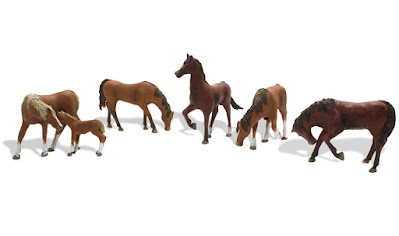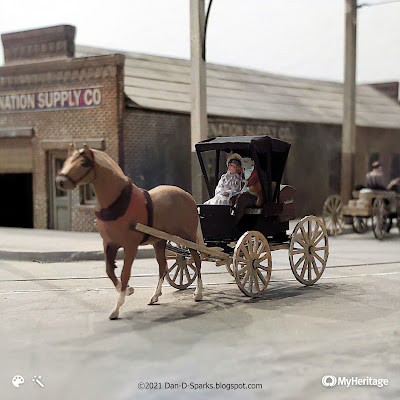Anybody Remember the Keystone Cops?
I thought it would be funny to model them.
After the demise of Jordan Highway Miniatures vehicles I started looking around for other period models. This Model T Ford is a 3d print from Robert Sprague 3D Designs on Shapeways. It's not as fine of a model as Jordan but I wanted to see what I could do with it.
Tru-color paint was used for the black. But the Floquil metallic paint used on the radiator and other details turned out too glittery for my taste. It works fine on tiny details like the hubcaps, but the broad expanse of the radiator and even the marker lamps is too much. A brass colored paint would look a lot better for this. As is typical of 3D prints the model has some visible strata from the printing process and some details are oversized to meet the 1mm minimum thickness.
But truth be told- I'm trying to get G scale results with HO scale models with this ultra close-up photography I'm doing. But really the model looks just fine when observing the scene when standing next to the layout.
So it is what it is. When it comes time to populate my layout with automobiles I'll reassess this model to see if I'll use it or not. And then I called the Model T project finished for now.
Then, while researching something unrelated, I came across this production still from a Keystone Cops flick. "Hm! I wonder if I could model that" I wondered to myself . "Well... I do have that Model T model and covering it with cops would hide most of it defects" I replied to myself. "Ah- but what about all those cops" I countered, "nobody manufactures HO scale cops like that". Darn! I was right. I was defeated. Until I came across this:
Preiser Unpainted Firemen. The uniforms are really similar and they even have those helmets like the Keystone Cops! Well what do you know? Everything fell into place. This is a feasible project after all. Well I gotta do it now!
Trying out different figures to see where and how many I can fit.
The 12 selected figures were primed with Tru-Color grey primer. Then they were painted with FolkArt craft paint. Not as nice as model paint but effective. The buttons and badges were painted with the same Floquil Brass glitter paint as the automobile.
Here is the photo set-up. My phone that I'm taking the pictures with doesn't fit under the overhead wires. So it is laying on a cardboard tube cut to length to keep the phone just above the wires. Under the camera lens is a First Surface Mirror set a 45 degree angle aimed at the scene. A flashlight is illuminating the "sky".
And voila! The completed scene.
I might revisit this at a later date. Add some billy clubs to their hands. I'll see if I can introduce the appearance of speed. Maybe turn those front tires so its making a hard turn and introduce some lean to the suspension. I'll take a look at those Artitech Model T's when they become available again.
But for now I'm satisfied. I think this photo is hilarious.
Yes sir- hilarious!
"Good job Dandy"
"Awe thanks Dandy"
Dandy
























































